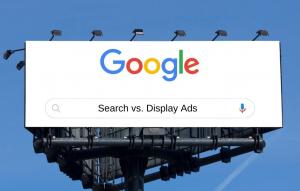SEAL BEACH, CA, UNITED STATES, February 10, 2023 /EINPresswire.com/ — Display ads can help raise awareness and generate interest, whether a small business or an established brand; it’s crucial to understand the different types of online advertising. Companies must understand the nuances between Google search vs. display ads to get maximum reach and engagement. Google search ads are triggered by typed searches, while display ads appear on websites and apps. Both serve different purposes and require a different strategy for placement and optimization. This article will discuss how to use both ad types to maximize your reach and ensure success. Read on to learn more!
What are Search Ads
Search ads are Google’s way of connecting potential customers with businesses that offer the products or services they’re interested in. When someone searches for a keyword related to your business on Google, your ad could appear at the top of the search results. Search ads are a great way to get a business in front of people who are already interested in what the business has to offer.
Google search ads are text-based ads that appear at the top of Google’s search results page when someone enters a query. They’re clearly marked as “Ads” and usually include the advertiser’s name and a brief description of their offering. Search ads are triggered by keywords the advertiser bids on through Google Ads.
What are Display Ads
Display ads, on the other hand, are designed to reach a wider audience. They appear on websites across the Internet, not just on Google. Display ads can be targeted to specific audiences using interests and demographics, so the advertiser can make sure their ad is being seen by people who are likely to be interested in what they are selling.
Display ads are banner ads that are seen on websites across the Internet. They come in all shapes and sizes and can include images, videos, or rich media. Display ads are typically sold through ad networks, which match up advertisers with websites that have space to sell. Like search ads, display ads are also triggered by keywords (though, in this case, they’re called “placements”).
Comparing the Metrics for Search and Display Ads
As a business owner, the advertiser wants to know where to spend their advertising for the best results. Google Search and Display ads are two popular options, but which one is right for the business? Let’s compare the metrics for each type so an informed decision can be made between Google search vs. display ads.
Google Search ads are text-based ads that appear in the search results when someone enters a relevant keyword. These ads are auction-based, meaning advertisers bid on keywords they think potential customers will use to find their product or service. The higher they bid, the more likely their ad will appear in the search results.
Display ads are image-based ads that appear on websites in the Google Display Network. businesses can target these ads to people based on interests, demographics, and previous interactions with their brand (such as visiting the website). Display ads can raise awareness of the brand or promote a specific product or service.
The metric most important for Google Search ads is click-through rate (CTR), which measures how often people who see the ad click on it. The CTR for Google Search ads averages 1.91%. This means that for every 100 people who see the ad, about two of them will click on it.
The most important metric for Display ads is the view-through rate (VTR), which measures how often people who see the ad go on to take a desired action (such as visiting the website).
Reasons to Use Search Ads
There are many reasons to use search ads. However, there are a few general guidelines that can help marketers decide whether or not search ads are right for their particular situation.
First, it’s important to consider the overall goals of the marketing campaign. If the goal is to build brand awareness or generate leads, then search ads may not be the best option. Display ads are usually more effective for these types of objectives. However, if the goal is to drive traffic to a specific landing page or promote a special offer, then search ads can be very effective.
Finally, it’s worth considering the target audience for the campaign. If the target audience is likely to use search engines frequently, they will probably see and click on search ads more often than other types of users. This means that search ads can be a good way to reach this particular group.
When Should a Strategy Include Search Ads
There is no one-size-fits-all answer to the question of when a strategy should include search ads. But here are some common reasons to use them:
1. Reach More Customers: Search ads allow advertisers to reach more customers by targeting those who are actively searching for their products or services.
2. Cost-Effective: Search ads are a cost-effective way to reach a target audience. They are also flexible, so the advertiser can adjust their budget as needed.
3. Increase Brand Awareness: Search ads can help increase brand awareness and reach new potential customers who may not be familiar with a brand.
4. Drive Sales: Ultimately, the goal of any advertising campaign is to drive sales. Search ads can help achieve this by reaching potential customers who are already interested in what is being offered.
Ultimately, the ideal search ad strategy is a decision that should be made on a case-by-case basis. There are many factors to consider, and what works well for one company may not work well for another.
Reasons to Use Display Ads
There are a few key reasons to use display advertising as a marketing strategy. First, display ads are highly visible and can be placed on websites that receive a lot of traffic. This means that the ad has the potential to be seen by a large number of people. Additionally, display ads are usually less expensive than other forms of advertising, such as pay-per-click (PPC) ads. And finally, display ads can be targeted to specific audiences, making them more effective than general advertising methods.
When Should a Strategy Include Display Ads
Display ads are a great way to reach out to potential customers and promote a product or service. However, there are a few things to remember when deciding if and when to use them.
For one, display ads need to be designed well to catch people’s attention, and even then, there’s no guarantee that they’ll actually click on the ad. Additionally, display ads tend to work best when they’re targeted at a specific audience; otherwise, they risk the ad being seen by people who have no interest in what is being sold.
There are certain times when display ads can be very effective. A display ad can help raise awareness and generate interest. Especially if the advertiser has a new product or service, they want to promote. Or if running a sale or special promotion, display ads can be a great way to drive traffic to a website or store.
Ultimately, it’s important to weigh the costs and benefits of using display ads before making a decision. If done correctly, they can be an excellent tool for promoting your business. But if not used carefully, they can be a waste of money.
Conclusion
Choosing between Google search vs. display ads both have their own advantages, so it’s important to consider which one will work best for a business before investing in either one. If the business is not sure where to start, a digital marketing agency can help create a comprehensive digital marketing strategy that includes both search and display advertising.
Janet Wilson
BLVD DIGITAL MARKETING
+1 562-453-0695
info@boulevarddm.com
Visit us on social media:
Facebook
Twitter
LinkedIn
![]()



